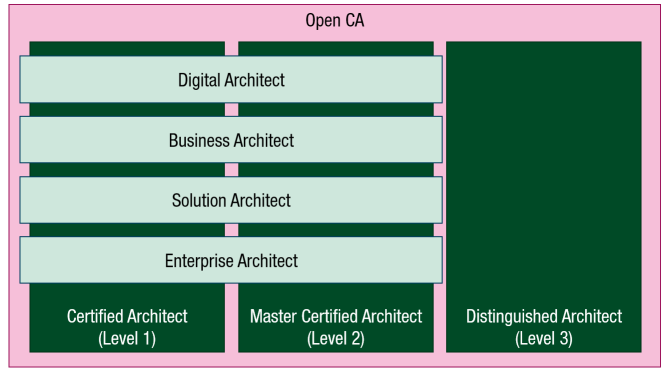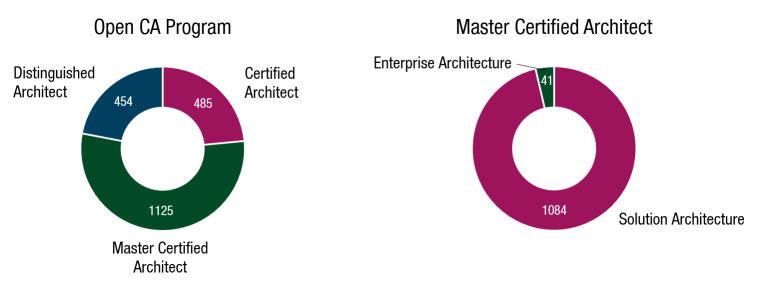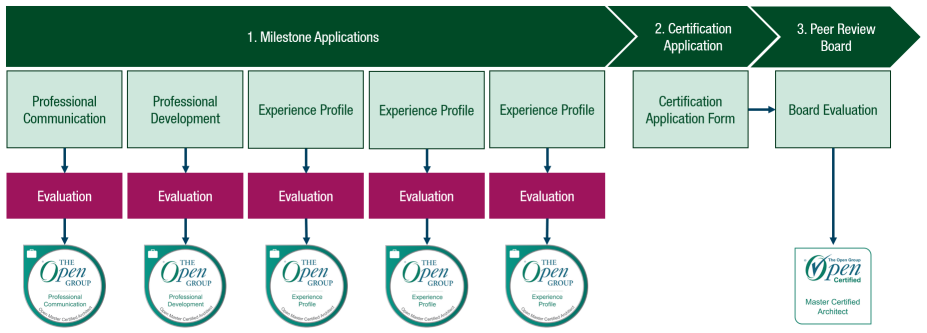Getting certified is important. It is especially important from a personal perspective. Certifications demonstrate that you have the qualifications, skills, and knowledge necessary to perform your job well. There is one downside to most certifications though. Since most certifications are knowledge-based, almost none of them will allow you to demonstrate your experience.
In this blog, we’re going to look at the different types of certifications that The Open Group offers for the architecture profession. The main focus will be on what steps you need to take and what the whole process looks like. I will explain in detail how to achieve the various milestones and how to earn the badges required for this certification.
Types of Certifications
When it comes to types of certifications, we can distinguish two types.
- Knowledge-based: The type of certification in which you study the material provided in a textbook or any form. To put it rather simply, it amounts to endlessly going through the material until the content is imprinted in the memory.
- Experience-based: This type of certification requires demonstrating experience by presenting different cases to third parties. It is important to pay close attention to the reasoning behind your work and the decisions you make.
As for the knowledge-based certifications, these are the most common certifications. We have probably all heard of them, or know someone in our inner circle who has achieved one such certification. One of the most well-known knowledge-based certifications is the TOGAF certification. The most recent version allows you to achieve the title of Enterprise Architect Practitioner. This certification resembles the TOGAF 9 Level 2 (Certified) certification from the past.
Lesser known are the experienced-based certifications The Open Group provides. There are four different certifications within The Open Group Open Professions program. For architects, there is the Open Certified Architect (Open CA) certification.
Open Certified Architect Program
The Open Certified Architect Program consists of four architecture disciplines.
- Digital Architect: Designs business processes to improve customer experience, increase profitability, and improve competitive position.
- Business Architect: Closely involved in shaping and fostering enterprise transformation initiatives and continuous improvement throughout companies of all sizes.
- Solution Architect: Designs, describes, and manages the solution engineering in relation to specific business problems. Solution architects are responsible for leading the practice and introducing the overall technical vision for a particular solution.
- Enterprise Architect: Connects an organization’s business mission, methodology and processes to its strategy and documentation with the help of an array of architectural models, or views. These provide a picture of how an organization’s existing and future requirements may be accomplished in an effective, agile, sustainable and flexible manner.
For each discipline, the levels Certified, Master Certified and Distinguished are available.
Open CA is the premier, global certification for certifying skills and experience in the architecture community.
The Open Group
Certification Levels
The Open CA Program recognizes three levels of certification.
- Certified Architect: Able to perform with assistance or supervision with a wide range of appropriate skills as a contributing professional.
- Master Certified Architect: Able to perform independently and take responsibility for delivery of solutions as lead professional.
- Distinguished Architect: Has significant breadth and depth of impact on the business through the application of their profession.
Some time ago, in 2022 to be exact, I completed the Open CA Certification Program myself. Since then, I can call myself a Master Architect in the Enterprise Architecture specialization.

The figure above illustrates the four disciplines (Digital, Business, Solution, and Enterprise Architect). They apply to the first two levels (Certified and Master Certified Architect). The third level, Distinguished Architect, focuses primarily on the strategic side of the profession. Therefore, it does not differentiate between the four disciplines mentioned above.
Some Numbers
The Open Group maintains a registry where you can be listed as a certified architect. This registry shows the following numbers for the Open CA Program.
There are a total of 2064 registered architects who have successfully completed the Open CA Program1.
- 485 hold the Certified Architect credential.
- 1125 hold the Master Certified Architect credential.
- 454 hold the Distinguished Architect credential.
Of the Master Certified Architects, 1084 have achieved the Solution Architecture specialization and only 41 have achieved the Enterprise Architecture specialization. Worldwide.

Structure of the Program
The Open CA Certification Program consists of a number of components divided into three phases.
- Milestone Applications: This first phase consists of answering questions about how you, as an architect, have communicated about the profession (Professional Communication) in recent years. You will also be asked to demonstrate what you have done to further your own development (Professional Development). Finally, the submission of two or three cases (Experience Profiles) is part of this first phase. This number depends on the level of certification you’re seeking.
- Certification Application: The second phase is to elaborate on the three cases described above. Here it is important to properly explain the reasoning behind the choices made.
- Peer Review Board: The third and final phase of the process to be completed consists of defending or further explaining the submitted experience before a Peer Review Board. This board consists of two or three certified architects from different parts of the world.

If the Peer Review Board agrees that you meet the stated conformance requirements, you will receive certification.
Milestone Applications (Phase One)
The first step in the certification process has three parts. First, you must achieve the Professional Communication milestone. This involves demonstrating experience in communicating about the profession. This includes consideration of both written and verbal communication. Three examples of each type of communication should be provided.
The same process applies to the second milestone, Professional Development. Again, evidence must be provided. The focus in this section is on continuing education (courses or self-study), knowledge of trends and techniques, knowledge of the industry in which you work, and knowledge of the field itself. It is also necessary to demonstrate the contributions you have made to the architecture community.
The final step of the first phase is to submit two to three cases in the form of an Experience Profile, depending on the level of certification you are seeking. The idea here is to describe your architectural work over the last few years. It is important that the work has a total duration of at least 36 months and was completed no more than three years ago. Each Experience Profile describes the role you held during the work, and the actions you performed. It is important to note that this should be described in great detail. Remember that someone unknown to you is reading and reviewing the Experience Profiles. The clearer and more complete they are, the easier it will be for the reader to understand what your role was in the whole.
The documents you submit for the Professional Communication and Professional Development milestones, as well as the Experience Profiles are all evaluated by peers. Once approved, you will receive a milestone badge fo each completed milestone that you will need for the follow-up process. The badges have a limited validity period depending on the amount of experience described.
Certification Application (Phase Two)
The second phase of the Open CA Program is all about the Certification Application. The name may be a bit misleading because it is not directly about submitting the certification application. What is meant by the Certification Application is the further explanation of the choices made from the Experience Profiles.
The Certification Application emphasizes architectural complexity, different types of architectures, and the design of viable solutions. The intent of this document is to show what was complex about the cases you described in the Experience Profiles. In particular, the reviewers are looking for an explanation of the use of multiple architectural dimensions and domains. They also want to know if you made certain choices deliberately, for example, by considering different types of architectures. Finally, you must provide evidence that demonstrates your understanding of the impact of your architectural decisions on the realization and operation of a solution.
The Certification Application is thus clearly a deepening of previously made and described decisions and solution directions. It is less about the overall approach and more about the reasoning behind it.
Peer Review Board (Phase Three)
The very last phase of the Open CA Program is the defense of your Experience Profiles and Certification Application before a panel of three architects. These architects are assigned by The Open Group, and you will have video calls with them. They will ask you questions about what you have written in the hopes of having a good conversation with you. During the video calls, it is important that you are able to explain not only what you did, but also why you did it and how you arrived at your decisions.
After the video calls, the evaluators will consult with each other. After a week or two, you will be notified of the outcome through The Open Group. If it is positive – that is, at least two of the three Review Board members found your defense (more than) satisfactory – you will receive the certification.
Tips to Get You Started
Completeness is especially important when filling out the documents. Make sure that the person receiving your input can visualize what you have written. Also, make sure you are telling your own story and not copying or imitating others. Not only is this an unfair approach, but it will also make it very difficult for you later on when you have to defend and answer questions about the cases you have submitted.
Another tip I would like to give is this: do not use AI tools to generate a case. Tell everything in your own words, based on your own experience. Don’t have the right experience right now? Then skip this certification process for now. It is necessary to be able to interpret your work correctly. This can only be done if you have the necessary experience. It is an experience-based certification for a reason!
What helped me a lot was writing the answers in my own language. I only translated the text into English after I had completed the entire document (I am referring specifically to writing an Experience Profile). Good to know: you will be evaluated on the content and work described, not on your command of the English language.
Best of luck on your journey!
- These statistics were requested on May 1, 2025. ↩︎







Leave a Reply